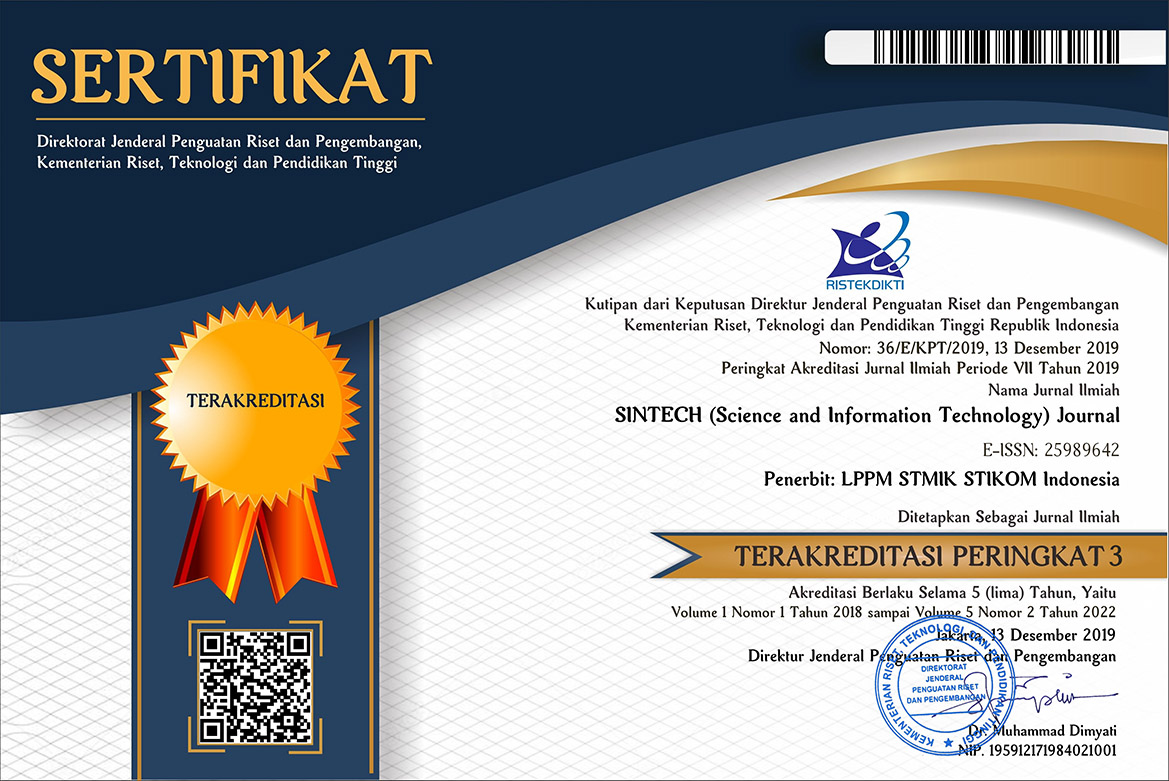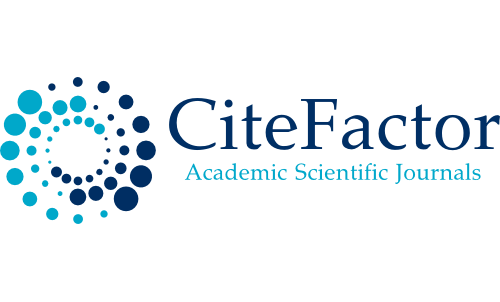
About the Journal
ABOUT SINTECH JOURNAL
SINTECH (Science and Information Technology) Journal is a journal published by Prahasta Publisher managed by the Directorate for Research and Community Service (DRPM) Institut Bisnis dan Teknologi Indonesia, with e-ISSN 2598-9642 and p-ISSN: 2598-7305. SINTECH Journal was first published in April 2018 and has a publishing period thrid in a year, namely in April, August, and Desember.
Focus and scope of SINTECH Journal includes: (a) Artificial Intelligence, (b) Image Processing and Pattern Recognition, (c) Data Mining, (d) Data Warehouse, (e) Big Data, (f) Data Analytics, (g) Data Science, (h) Natural language processing, (i) Software Engineering, (j) Information System, (k) Information Retrieval, (l) Mobile and Web Technology, (m) Geographical Information System, (n) Decission Support System, (o) Virtual Reality, (v) Augmented Reality, (q) IT Incubation, (r) IT Governance.
All articles in SINTECH Journal will be processed by the editor through the Online Journal System (OJS), and the author can monitor the entire process in the member area. Articles published in SINTECH Journal, both in hardcopy and soft copy, are available as open access for educational, research and library purposes, and beyond that purpose, the SINTECH Journal editorial board is not responsible for copyright infringement.
HISTORY JOURNAL
Initially DRPM Institut Bisnis dan Teknologi Indonesia published a journal that aimed to accommodate campus internal lecturers at Institut Bisnis dan Teknologi Indonesia in publishing scientific papers. Because the lecturers who want to carry out publications come from various fields of science, such as computer science, electrical engineering, mathematics, language, management, accounting, etc., the published journal seems not to have a clear focus area (accepting all types of articles). In addition, efforts to improve journal management by DRPM, as well as accreditation demands for scientific periodicals / journals determined by related parties, caused DPRM to stop publishing the journal.
Science and information technology (SINTECH) Journal is one of the journals published by Prahasta Publisher managed by DRPM Institut Bisnis dan Teknologi Indonesia to facilitate the publication of scientific articles of lecturers in the fields of science related to science and information technology. This name was chosen due to the rapid development of science and information technology in this era and the prospect of continuing to grow. The science and technology developed is not limited to efforts to find and / or develop programs or application / system makers, but also related to the application of programs or systems that have existed in various aspects of life. Therefore the focus areas of writing received are related to data processing, artificial intelligence, pattern recognition, bioinformatics, virtual reality, information systems, games on mobile devices, and so on.
With the presence of this journal, it is expected that journal management in DRPM Institut Bisnis dan Teknologi Indonesia will be more focused on one science cluster and meet applicable standards. Hopefully the publication of this journal can provide new information and inspiration as well as add insights and examples of the application of weighted information and science to stakeholders.
OPEN ACCESS POLICY
The author's copyright in the SINTECH (Science and information technology) Journal, assigns that the publication of published articles is owned by the editorial board with the author's approval, but the rights are still with the author. The legal rules for accessing digital electronic articles are under license  Attribution-NonCommercial-ShareAlike 4.0 International (CC BY-NC-SA 4.0), which means that the SINTECH Journal has the right to store, modify, manage databases, maintain and publish articles without the author's permission, but the author as the copyright holder is still written as it is. Articles published in SINTECH Journals, both in hard and soft copy forms are available as open access, for educational, research and library purposes, and beyond that purpose, the editorial board of the Language and Language Journal is not responsible for illegal copyright infringement. This journal also applies LOCKSS and CLOKSS archiving.
Attribution-NonCommercial-ShareAlike 4.0 International (CC BY-NC-SA 4.0), which means that the SINTECH Journal has the right to store, modify, manage databases, maintain and publish articles without the author's permission, but the author as the copyright holder is still written as it is. Articles published in SINTECH Journals, both in hard and soft copy forms are available as open access, for educational, research and library purposes, and beyond that purpose, the editorial board of the Language and Language Journal is not responsible for illegal copyright infringement. This journal also applies LOCKSS and CLOKSS archiving.
COPYRIGHT NOTICE
Author(s) who publish article in SINTECH (Science and information technology) Journal, agree to the following terms:
- Authors retain copyright and grant the journal right of first publication with the work simultaneously licensed under license Attribution-NonCommercial-ShareAlike 4.0 International (CC BY-NC-SA 4.0) that allows others to share the work with an acknowledgement of the work's authorship and initial publication in this journal.
- Authors are able to enter into separate, additional contractual arrangements for the non-exclusive distribution of the journal's published version of the work (e.g., post it to an institutional repository or publish it in a book), with an acknowledgement of its initial publication in this journal.
- Authors are permitted and encouraged to post their work online (e.g., in institutional repositories or on their website) prior to and during the submission process, as it can lead to productive exchanges, as well as earlier and greater citation of published work.
PEER REVIEW PROCESS
The article that has been sent to SINTECH Journal will be through two review process namely pre-review and review. Pre-review process of the article is done by managing director that include:
- Focus and Scope: The article being sent should in accordance with the scope of SINTECH Journal, focus and scope can be seen here. The article outside the scope of SINTECH Journal will be rejected.
- Plagiarism Check: Plagiarism check and article similarity are done by using google schoolar and itenthicate with maximum score 15%. Article that has similarity check above 15% will be returned to the writer for revision.
- References: references used in the article are minimum 10 references that consist of 80% primary sources and 20% secondary sources. References use IEEE style and made by using references managing software like Mendeley.
- Template: the submitted article should in accordance with the template in SINTECH Journal which can be seen and downloaded here.
If from the four components, there is something not in accordance, then the article will be returned to the writer to be revised. Writer is given time for seven days to revise the article and send it back.
When the four components in the review process are fulfilled, then the article will be continued to be reviewed by the reviewer through editor. The substances review process is done by three reviewer in Double Blind Peer Review. Reviewer can give recommendation such as:
- Accept Submission: article is accepted to be published without having revision in substances.
- Revision Required: the article with minor revision, article is sent to the writer to be revised (when the writer has sent the revision, article can be accepted to be published)
- Resubmit for Review: the article with major revision. After revision is done by the writer, article is resubmitted to the reviewer to be reviewed again ( maximum three times resubmit), If the article is not quite right in substance after the fourth review, then reviewer is allowed to give recommendation as Decline Submission.
- Resubmit Elsewhere : in substance, article is considered as less suitable and suggested to be submitted into other journal
- Decline Submission: article is rejected by the reviewer to be reviewed with two reasons, (1) reviewer rejects because of a reason (not related to article substances), then the article is sent to another reviewer. (2) rejected article in substance is considered less suitable to be published in journal.
ARTICLE PROCESSING TIME ON SINTECH JOURNAL
Pre-review process takes time about 3-7 days
Writer has 1 week to revise the article in pre-review stage. Writer who has not revised the article at that time and without giving any statement, then the managing director has done meaningless work, then the article will be rejected.
Review process by the reviewer is done about 2 weeks every round. The numbers of round in review process depends on the reviewer recommendations.
Writer is given one week to revise the article from reviewer, and if the writer does not send the revision at the specified time without any statement, then editor and reviewer has done meaningless work, then the article is rejected.
The duration of the article starts from the submitting until production stage in detail can be seen in the image below.

LOA (LETTER OF ACCEPTANCE)
LOA on SINTECH Journal consists of 2 types, those are LOA that will be sent through the writer email automatically by OJS when the article has been accepted to be published.
Second LOA is manual LOA that will be attached on the discussion section on OJS when the article has been accepted to be published.
LOA will only be given to the writer when the article has entered production stage.
ARTICLE REJECTION
Manuscript rejection or manuscript cancellation on SINTECH Journal consists of two types, namely rejection or withdrawal without fine, and rejection or withdrawal with fine. Withdrawal without fine happens because of three things, those are:
- Do not in accordance with the focus and scope.
- Writer do not revise the article both in pre-review and review stage along the specified tine without any reason.
- Article does not pass pre-review stage for three times
- Article rejection by recommendation of the reviewer related to substances/content of the article
Rejection or withdrawal with fine happens because of two things, those are:
- Writer that takes his writing with any reasons when the article has been proceed (enter the pre-review stage by the managing director).
- There is duplication in publication, where the writer do submitting article in several journal and one of them is SINTECH Journal, or the article has been published in another journal and re-submit on SINTECH Journal.
Article withdrawal after being proceed or duplication in publication is a wasting time where managing director, editor and reviewer has done a meaningless activity so in this case the writer is fined about Rp. 1.000.000,- Cancellation will be done when the writer has done the payment and sent the receipt of payment to the editor of SINTECH journal. If the writer does not agree to pay the fine, then the writer will be put into blacklist with the consequences; the writer will be blacklisted from SINTECH Journal, so the writer could not submit the article.
PUBLICATION ETHICS AND MALPRACTICE STATEMENT
These guidelines are fully suitable with the COPE Principles of Transparency and Best Practice Guidelines and the COPE Code of Conduct. For more details can be seen in the following link: https://publicationethics.org
Section A: Publication and authorship
- All submitted papers are subject to strict peer-review process by at least two international reviewers that are experts in the area of the particular paper.
- Review process are blind peer review.
- The factors that are taken into account in review are relevance, soundness, significance, originality, readability and language.
- The possible decisions include acceptance, acceptance with revisions, or rejection.
- If authors are encouraged to revise and resubmit a submission, there is no guarantee that the revised submission will be accepted.
- Rejected articles will not be re-reviewed.
- The paper acceptance is constrained by such legal requirements as shall then be in force regarding libel, copyright infringement and plagiarism.
- No research can be included in more than one publication.
Section B: Author responsibilities
- Authors must certify that their manuscripts are their original work.
- Authors must certify that the manuscript has not previously been published elsewhere.
- Authors must certify that the manuscript is not currently being considered for publication elsewhere.
- Authors must participate in the peer review process.
- Authors are obliged to provide retractions or corrections of mistakes.
- All Authors mentioned in the paper must have significantly contributed to the research.
- Authors must state that all data in the paper are real and authentic.
- Authors must notify the Editors of any conflicts of interest.
- Authors must identify all sources used in the creation of their manuscripts.
- Authors must report any errors they discover in their published paper to the Editors.
Section C: Reviewers responsibilities
- Reviewers should keep all information regarding papers confidential and treat them as privileged information.
- Reviews should be conducted objectively, with no personal criticism of the author
- Reviewers should express their views clearly with supporting arguments
- Reviewers should identify relevant published work that has not been cited by the authors.
- Reviewers should also call to the Editor in Chief’s attention any substantial similarity or overlap between the manuscript under consideration and any other published paper of which they have personal knowledge.
- Reviewers should not review manuscripts in which they have conflicts of interest resulting from competitive, collaborative, or other relationships or connections with any of the authors, companies, or institutions connected to the papers.
Section D: Editors responsibilities
- Editors have complete responsibility and authority to reject/accept an article.
- Editors are responsible for the contents and overall quality of the publication.
- Editors should always consider the needs of the authors and the readers when attempting to improve the publication.
- Editors should guarantee the quality of the papers and the integrity of the academic record.
- Editors should publish errata pages or make corrections when needed.
- Editors should have a clear picture of research funding sources.
- Editors should base their decisions solely one the papers’ importance, originality, clarity and relevance to publication scope.
- Editors should not reverse their decisions nor overturn the ones of previous editors without serious reason.
- Editors should preserve the anonymity of reviewers.
- Editors should ensure that all research material they publish conforms to internationally accepted ethical guidelines.
- Editors should only accept a paper when reasonably certain.
- Editors should act if they suspect misconduct, whether a paper is published or unpublished, and make all reasonable attempts to persist in obtaining a resolution to the problem.
- Editors should not reject papers based on suspicions, they should have proof of misconduct.
- Editors should not allow any conflicts of interest between staff, authors, reviewers and board members.













1.png)




